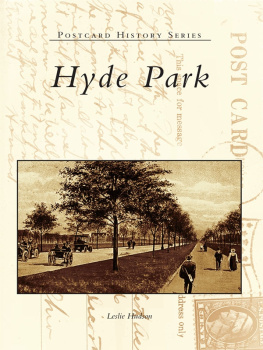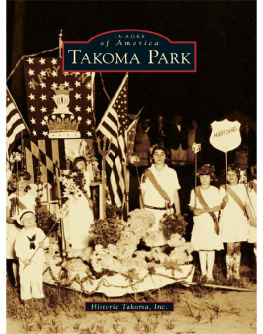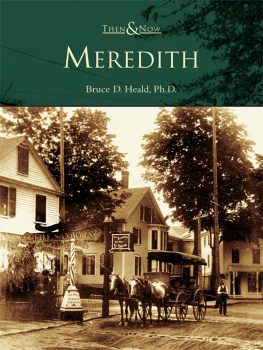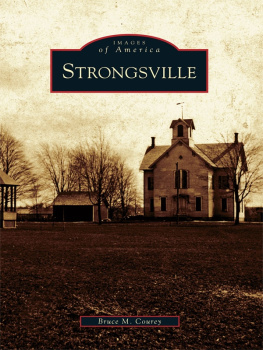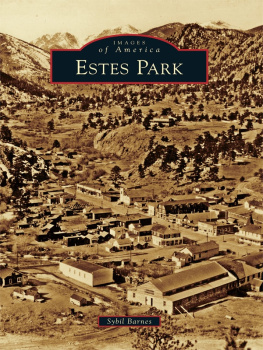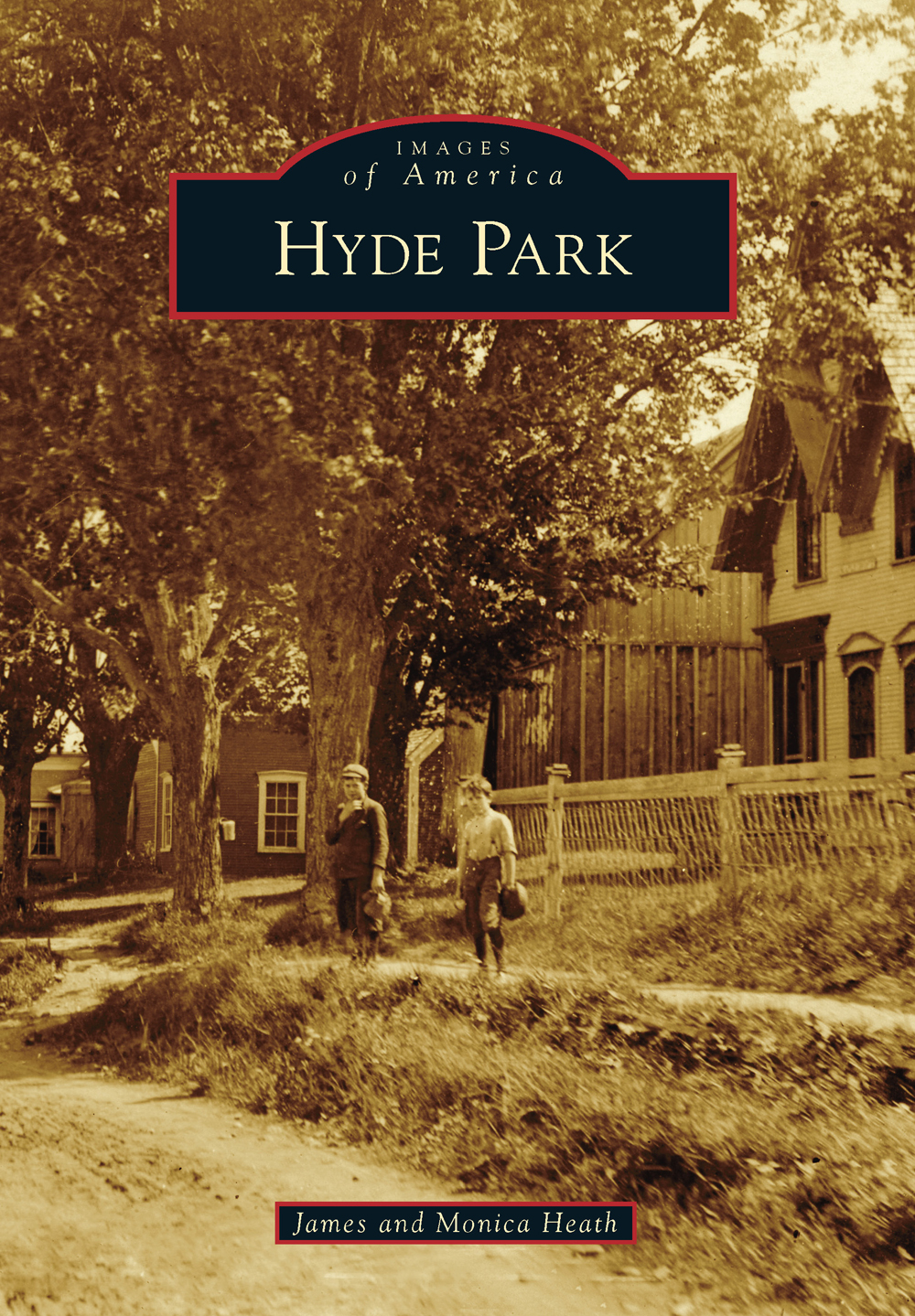
IMAGES
of America
HYDE PARK

This c. 1920 view of North Hyde Park was taken from the hillside located west of the village. Note the clearings on the distant hillsides, which are today forested. Many clearings, such as these, were needed for the numerous farms located in and around town. (Courtesy of the Graves/McAllister family.)
ON THE COVER: This image shows two young boys on Maple Street (later renamed Ferry Street), who, by the looks of the gloves on their hands, appear ready to play baseball. Many sports activities of this nature were very popular with youth during this time period. It should be noted that this street also carried the name Water Street when the village was first settled. (Courtesy of the Heath/Savage family.)
IMAGES
of America
HYDE PARK
James and Monica Heath

Copyright 2014 by James and Monica Heath
ISBN 978-1-4671-2228-3
Ebook ISBN 9781439647561
Published by Arcadia Publishing
Charleston, South Carolina
Library of Congress Control Number: 2014932468
For all general information, please contact Arcadia Publishing:
Telephone 843-853-2070
Fax 843-853-0044
E-mail
For customer service and orders:
Toll-Free 1-888-313-2665
Visit us on the Internet at www.arcadiapublishing.com
We would like to dedicate this book to our children, Makesha L. and Jordan J. Heath, and also our granddaughter, Monica Marie Heath, as an inspiration to learning and preserving our local history. We would also like to dedicate it to all the citizens of Hyde Park, both past and present, whose efforts go unsurpassed in making this such a great community.
CONTENTS
ACKNOWLEDGMENTS
We would sincerely like to say thank you for the generosity and support we received from community members, friends, and families who supported us and provided images in the authoring of this book. We are also indebted to the Vermont Historical Society and local historians for providing us with historical information. We would like to also acknowledge the following individuals and organizations for their contributions of photographs and images that they allowed us to use in this book: Francis Favreau, Robert and Caroline Jones, Roberta Grimes, Jane and Eleanor (Grimes) Goodrich, Marguerite Stewart, Norma (Thompson) Savage, Velma (Thompson) Rushford, Everton and Marjorie Graves for the McAllister collection, Don and Doug Bullard for the Vernon Bullard collection, Robert Barnes, Donald Johnstone, Linda Jones, Wade Larose, John and Judy Davis, Amy Noyes and the Lanpher Memorial Library for the Page/McFarland collection, Loren and Jean Aither, the late Ruby (Amadon) Day, Arland Bud Ploof, Evertt Demeritt, and Madonna Parker.
We would like to also acknowledge the following books, which provided us with a great deal of historical information:
Child, Hamilton. Gazetteer and Business Directory of Lamoille and Orleans Counties, Vt. Syracuse, NY: Journal Office, 1883.
Hemenway, Abby Maria. The Vermont Historical Gazetteer, Vol. 2. Burlington, VT: A.M. Hemenway, 1871.
Town of Hyde Park and its Bicentennial Committee, The. Hyde ParkVermont Shire Town of Lamoille County. Essex Publishing Company, 1976.
Town of Hyde Park History Book Committee, The. Hyde Park, Vermont Then and Now. Hyde Park, VT: Town of Hyde Park Book Committee, 2007.
INTRODUCTION
Hyde Park is a small town in Vermont rich in history and culture. As with so many small towns in Vermont, its original settlement was established by Revolutionary War soldiers from Massachusetts, Connecticut, New Hampshire, and New York who passed through this region en route to Canada and the surrounding forts through the Lake Champlain corridor. The soldiers who knew each other provided a common link among the small towns being granted in this northern region. Hyde Park would see two of these early settlers, John McDaniel and Capt. Jedediah Hyde.
Captain Hyde, for whom the town would be named, was born on August 24, 1738, in Norwich, Connecticut. He was the son of Rev. Jedediah Hyde, a Separatist of the Congregational Church. Captain Hyde was an officer in the Revolutionary War and served in both the Army and the Navy. He also fought at the Battle of Bunker Hill. From January 1, 1777, to January 1, 1780, he was quartermaster sergeant of the 4th Regiment of the Connecticut Line. After obtaining the rank of captain, he was always known as Capt. Jedediah Hyde and was quite noted for his politeness and easy address, as quoted by Zadock Thompson. In the following years, he married Mary Waterman and had eight children. His firstborn from this marriage was a son, Jedediah Jr., who was born on November 5, 1761, in Norwich, Connecticut. At the age of 14, Jedediah Jr. also joined the Revolutionary War. After the war, he became a schoolteacher and taught in Williamstown, Massachusetts, and Pawlet, Vermont. Both he and his father were surveyors and would survey the lines for the town of Hyde Park and its proprietors.
When Lamoille County was formed in 1838, Hyde Park was appointed the distinction of being the shire town of the county by the Vermont Legislature due to its geographical and political location. When first chartered on August 27, 1781, the town had an area of 23,040 acres and was bounded north by Eden, east by Wolcott, southeast by Morristown, and west by Johnson. This changed somewhat in 1899, when Morrisville and Hyde Park reached a compromise on the annexation of property that was approved by the Vermont Legislature. This would reduce the towns total acreage to 21,210. It also should be noted that the original intent of the proprietors was to have the village sited where Albert M. Whitcombs farm was located in Centerville.
In years to come, Hyde Park would experience much economic growth and development due to the ingenuity of pioneering families, such as the Page, Fitch, McFarland, Campbell, Bullard, and McAllister families, amongst others. Roads would improve, farms would develop, churches and schools were built, and a number of other businessesincluding blacksmiths, cobblers, stores, printers, and millswould come into town. With his successful calfskin business, Carroll Smalley Page was one of these influential men. He also had a strong political career, serving as governor of Vermont, a Vermont representative and senator, and a US senator.
Our intent is to reflect a small portion of Hyde Parks history and growth through the photographs and images displayed within this book. We wish to visually show that the heartbeat of the community is its people and the roles they play within that community. You will see images of merchants, farmers, teachers, students, loggers, mill workers, homemakers, and so many others who make up the pulse of our community. You will sense, feel, and reflect on the changing times as you view the various photographs and images. You will be able to take a walking tour through both Hyde Park and North Hyde Park Village as you go from page to page.
In closing, you will not be disappointed with the rich history of this unique town. Like so many towns, its history links us all together through the brave men and families who ventured forward to seek out a new life and culture.
One
NORTH HYDE PARK
(THE NORTH VILLAGE)

Next page

